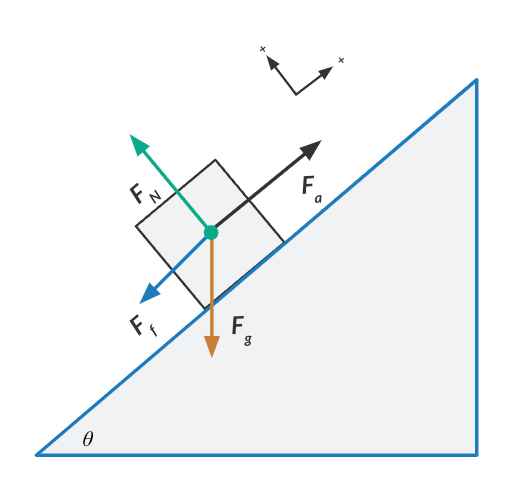2. Force, Torque, and Work
1/50
There's no tags or description
Looks like no tags are added yet.
Name | Mastery | Learn | Test | Matching | Spaced |
|---|
No study sessions yet.
51 Terms
Force
Interaction that causes an object to accelerate
Newton (N)
Unit of force; 1 N = kg*m/s2 (amount of force necessary to accelerate 1 kg by 1 m/s2)
4 Natural Forces:
Gravitational
Electromagnetic
Strong Nuclear Force
Weak Nuclear Force
Gravitational Force (Fg)
Force exerted by gravity on mass at a distance
Electromagnetic Force (FE)
Electrostatic force
Contact Force
Force exerted when objects are touching (Normal and friction forces)
Normal Force (FN)
Force acting perpendicular to surface, preventing object from passing through it
Friction Force (f)
Force that acting parallel to surface, that the surface exerts on an object trying to slide across it
Tension Force (FT)
Force exerted by ideal string, allowing contact/pushing forces exerted at a distance (pulley)
Centripetal Force (Fc)
Force acting on an object, causing it to move in a circular path
Spring/Elastic Force (Fs)
Force exerted by spring or elastic material when it is stretched or compressed; Follows Hooke’s Law (Fs = -kx)
Newton’s Laws
Law of Inertia
Sum of Forces = mass x acceleration
Equal and Opposite Forces
Newton’s First Law
An object at motion/rest will stay in motion/rest unless acted upon by an outside force (Fnet = 0 at equilibrium)
Newton’s Second Law
The sum of forces = ma (Fnet = ma)
Newton’s Third Law
Forces come in pairs; FAB = -FBA (equal and opposite forces)
Free Body Diagrams
Representation of all forces acting on an objects

fk =
μkFN (μk = kinetic friction constant)
fs =
μsFN (μs = static friction constant)
Center of Mass (xcenter) =
(x1m1 + x2m2…)/(m1 + m2…)
Static Friction
Friction force preventing an object at rest from moving (pushing a box and it not moving)
Kinetic Friction
Friction force acting on moving object, trying to stop it from moving (after you’ve gotten the box to move)
If a force is applied to an object but doesn’t move:
Fapp < Fmax
What are kinetic and static coefficients dependent on?
Each material-surface pairing
Key point to kinetic and static friction:
More force is needed to get an object to move than is needed to keep that object in motion (overcoming static harder than overcoming kinetic friction)
Air Resistance (Drag)
Opposes motion of moving object by v2; affected by 4 factors
4 Factors Affecting Drag
Air density (medium)
Object velocity (v2)
Object cross-sectional area
Drag coefficient (based on object properties)
When drag = gravitational force…
Terminal velocity has been reached; object stops accelerating
For boxes on incline, gx is always…
gsinθ (parallel)
Pulleys
Include tensions forces to allow angle force is transmitted through to change
How to solve pulley questions:
Draw FBDs for each mass on the pulley
Tension force always points up to pulley, opposing gravity
The forces acting on the two masses should be the same
Think of the two masses as the same (m1+m2)
Only the gravitational force magnitudes matter
Gravity
Attraction between objects that have mass
Fgravitational =
(G*m1m2)/r2 (Ex. Sun and Earth in circular motion)
Outside Earth instantaneous velocity is…
Perpendicular to the force of gravity
Hooke’s Law
Fs = -kx
k = spring constant (N*m)
x = amount stretched/compressed
A higher spring constant (k) means…
The spring is stiffer; requires more force to stretch/compress
Torque
Rotational force (often applied to lever at a distance away from object)
Fulcrum
Point around which an object rotates
τ (torque) =
F*dsinθ (N*m)
d = distance between fulcrum and applied force
θ between lever arm and force
To achieve the most torque…
Apply force perpendicular and as far from fulcrum as possible
Think of torque rotation as…
Clockwise or counterclockwise
Energy
What accomplishes work (Joules, 1 N*m = kg*m/s2)
Work =
Fdcos(θ) (Joules, kg*m/s2)
Conservative Forces
Path-independent (displacement)(work done by conservative force doesn’t rely on path); Fg, FE, Fs
Non-conservative Forces
Rely on distance or path; friction, air resistance
Force vs. distance Graph
Area under curve = Work
Why is moving an object up and down have W = 0?
Because displacement is 0 (returning to start position)
Mechanical Advantage
Being apply to apply less force than usually needed by using a different apparatus (seesaw); NOT do less work
What will have mechanical advantage?
The device/method that needs less force but does same work
Mechanical advantage =
Length of incline/height of incline (pushing vs pulling up)
Power =
Work/Δt (Watt or J/s) = F*v ← only used in some cases
Power
How quickly work can be expended (quicker = more power)